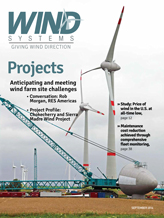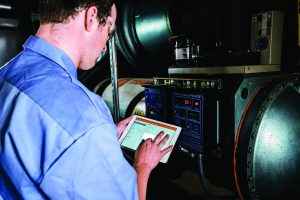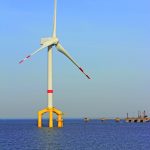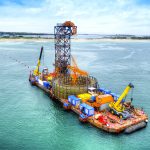After a lackluster 2013 for wind power development, the wind market is once again growing. According to a Bloomberg New Energy Finance report, installations this year could reach 6.5 GW and grow to 8.5 GW in 2015. As wind development continues on its upturn, the focus is moving from “whether” to invest in wind power to “how” to make sure projects succeed.
This is no small issue. The development of wind projects — whether a single turbine or larger wind farms — are huge undertakings. They require substantial equipment and complex infrastructure to support and operate that equipment.
One of the most important infrastructure elements, yet one that is virtually invisible, is site preparation. Large-scale energy projects aren’t typically developed on pristine, undeveloped land. Rather, they are often located on brownfields or other sites that have previously been used for industrial or other functions, and which have been abandoned or deemed unsafe for traditional usage. But even though wind projects are often located on discarded land, that land is essential to the success of any project. It needs to undergo strict mitigation to assure that the energy-producing equipment can operate safely, and the structural integrity of the soil needs to be established so it can support the heavy equipment that’s necessary to provide wind power.
What’s located below ground is just as important as what’s located above. Therefore, it is essential for a project’s environmental team to be actively involved from a wind project’s earliest days.
Most sites retain historic relics from the past. For the typical brownfield site, which may have seen any number of previous industrial uses, that could mean presenting a smorgasbord of different types of processed waste, metals, petroleum byproducts, and chemical contaminants. So, the essential first step in developing a site for wind development is to conduct a comprehensive environmental investigation to determine what contaminants are present and provide the necessary information for creating a successful mitigation plan. Some of the contaminants can require significant interaction with regulatory authorities in order to properly handle and dispose of the impacted material. For instance, if the subsurface material includes polychlorinated biphenyls (PCBs), there could be requirements to obtain both State and Federal (EPA) approvals while characterizing the site, and before the material is disposed. Depending on the concentration of PCBs, environmental samples containing PCBs detected at concentrations >50 mg/kg (or at any concentration if not authorized for use under 40CFR §761.61) would be subject to the Toxic Substances Control Act (TSCA), and the site would be regulated for both cleanup and disposal under §761.61. Cleanup activities may require notification to the EPA and the State regulatory authorities and depending on the site history and conditions, EPA may authorize more practical sampling, clean-up, or disposal procedures that are not prescribed in the regulations.
In addition, if there is subsurface material encountered that contains asbestos containing material (ACM), there may be requirements to prepare and obtain approval for an Asbestos Abatement Work Plan. The plan must comply with the Environmental Protection Agency’s (EPA) National Emissions Standards for Hazardous Air Pollutants (NESHAPs) regulations. Personnel that are hired to perform this work must be have specific state licenses to prepare work plans, perform construction administration, conduct project monitoring and inspections.
 These additional regulatory activities may also require that public notice be provided to area stakeholders prior to construction and regulatory approval. When performing construction on impaired property, the public notice activities and regulatory approval process can take from as little as a few weeks to several months. This should be factored into the overall permitting and construction schedule to avoid any surprises.
These additional regulatory activities may also require that public notice be provided to area stakeholders prior to construction and regulatory approval. When performing construction on impaired property, the public notice activities and regulatory approval process can take from as little as a few weeks to several months. This should be factored into the overall permitting and construction schedule to avoid any surprises.
While there are certainly contaminants, such as radioactive waste, that will pose immediate and continuous health risks if left in place, more often than not, contaminants can be safely capped and left onsite. Capping involves containing contaminated soil within retaining walls and placing it upon an impervious liner cap. The contaminated soil is then covered with an additional two to four feet of clean soil. Using the capping approach rather than removing and disposing of contaminated soil can cut remediation costs by as much as 75%, so it’s easy to see why private and public developers would prefer to go this route.
When creating a turbine foundation and assuring the integrity of the cap, it’s not enough to merely consider the weight of the piles that will support the turbine and the depth to which they will be driven. The piles and turbines are enormous and they require very large equipment to transport and install them. The cap and site foundation need to be designed to withstand the rigors of installation, as well as the day-to-day operations once the turbines are up and running. This is particularly important when building on historic urban fill. Urban fill almost always is a mixture of heterogeneous materials, making it very difficult to design the foundation. This has generally required making a unique site-specific manufactured fill by mechanically screening out unwanted material and mixing with imported material to create a satisfactory fill material suitable for development. This often means implementing construction controls to prevent excessive equipment loads from trucks, cranes, and other installation equipment. A cribbing system can also be implemented to distribute the weight of construction equipment.
The threat of erosion is also a key consideration, both during construction and when the turbines are operational. If the land on which the wind technology is installed suffers erosion, brownfield contaminants can escape the site and infiltrate adjacent land. At the same time, erosion can undermine the structural integrity of the wind equipment itself. The potential threat of erosion to the structure can’t be overstated. Wind turbines are large structures that require considerable sub-surface supports. It is essential to create an environment beneath the turbines that is safe and stable. Therefore, erosion and sedimentation control plans are key elements of any development. This typically includes the installation of silt fencing, haybale protection around groundwater extraction wells, and catch basin inlet filters to catch and contain storm runoff when it rains.
Additional protection can be offered through the installation of a subsurface stormwater detention system, which can temporarily store stormwater from the site and manage its infiltration into the site. Stormwater mitigation is particularly important in this era of climate change because major storms are becoming severe and frequent.
With the turbine revolution once more gaining steam, developers of wind power projects need to be aware of all of the infrastructure challenges they are likely to face. Some of the most serious issues will be found below ground, and at first glance, will be undetectable. That’s why a project’s environmental team should be involved from the very beginning of the planning stage and to the project’s completion. By including environmental pros who can identify contaminants and other risks, and create plans to address them, wind power developers can save themselves numerous headaches — as well as a lot of money.

































